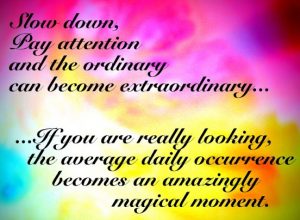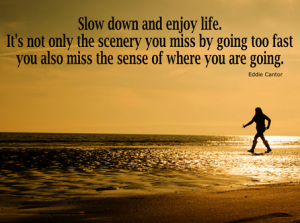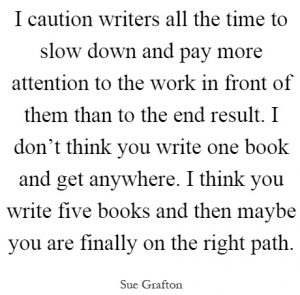 The psychologist, Paul Ekman. who discovered the micro expressions slowed down the film to see the emotion that gave the suicidal woman’s despair away.
The psychologist, Paul Ekman. who discovered the micro expressions slowed down the film to see the emotion that gave the suicidal woman’s despair away.
Slowing down your reactions will show you your real emotions… so you know, so you know what you are running away from.
Slowing down you may be able to find your strait and narrow… your path to your own happiness and fulfillment.
Fast isn’t going to cut it.
The fence that is built fast will fall down fast… and it is true for everything.
And interestingly everyone is looking for fast, push button, rapid… and everyone is unhappy. No accidents here.
 The most important turning point for me was losing my privilege to drive. Not having a car completely eliminated the previously normal reaction to anything confronting, unpleasant, challenging, or hard: running away.
The most important turning point for me was losing my privilege to drive. Not having a car completely eliminated the previously normal reaction to anything confronting, unpleasant, challenging, or hard: running away.
I still am confronted a lot, but because there is no place to run, I am more and more choosing to look at what seems to be unconfrontable… and look at it.
Stare the tiger in the face.
I am also catching and taming a lot of knee-jerk reactions. As a company owner, I used to be the Firing Queen… hired fast and fired even faster. No prosperity as a result never knocked me conscious. Only slowing down has.
 It’s uncharted territory to be patient, to give the benefit of the doubt, to allow all the answers to come to me, to emerge, as if from deep water. It is more alien from my personality and my persona as anything I do or have ever done… I am looking at myself with amazement as I am changing.
It’s uncharted territory to be patient, to give the benefit of the doubt, to allow all the answers to come to me, to emerge, as if from deep water. It is more alien from my personality and my persona as anything I do or have ever done… I am looking at myself with amazement as I am changing.
All movies are fast nowadays, so the only way to slow them down is to stop them to give me time to catch up, and to take a contemplation break… sometimes longer than the movie was.
This morning I read the Monday Morning Memo by Roy Williams, the advertising man. His memo is for business owners…
Norman Rockwell was an illustrator of fiction.
He never showed us America as it really was, but America as it could have been, should have been, might have been. His images caused an entire generation to vividly remember experiences we never had.Rockwell showed my generation a fictional America and we believed in it.
I don’t want to mention client names and I’m sure you’ll understand why, but my most successful ad campaigns have been built on exactly that kind of fiction.
Not lies. Fiction. There’s a difference.
Fiction is romanticized reality, showing us possible futures and the best of the past, leaving out the dreary, the mundane and the forgettable. It is a powerful tool of bonding. Properly used, fictional characters attract new customers and deepen customer loyalties. But predictable characters hold no interest for us. It is conflicted characters – those with vulnerabilities, weaknesses and flaws – that fascinate us immensely.
A recently published study in The Journal of Social and Personal Relationships suggests that fictional friends may be as valuable as “real” friends, particularly when life-partners watch television shows together.
“…our studies show that sharing the social connections provided by TV shows and movies can deepen intimacy and closeness. Furthermore, watching TV shows and movies together may provide couples who lack access to a shared social network of real-world friends with an alternate means of establishing this shared social identity.
Previously, sharing a social world with a partner has been conceptualized in terms of sharing real-world social experiences.2 However, creating these experiences may not always be possible. Fortunately, humans are remarkably flexible in finding ways to fulfill their social needs.3 When people’s need for social connections are undermined, they turn to a variety of social surrogates that provide alternate pathways to meet this need, including comfort food,4 photos of loved ones,5 pets,6 and media like TV shows and movies.7”
Recurrent characters in advertising fit into that last category of “media like TV shows and movies.”
In fact, fictional characters shine so brightly in our minds that we have created a word – metafiction – for those moments when fictional characters become aware that they are fictional.If you doubt what I say, all you need do is suggest to Indiana Beagle that he isn’t real. You will quickly and painfully be made aware of how real a fictional character can become.
It is the architecture of our brains that makes fiction so powerful.
Humans are the storytelling animal.
You have about 100,000 times more synapses in your brain than sensory receptors in your body. If brain synapses were strictly equal to sensory receptors – which they are not – this would mean that you and I are 100,000 times better equipped to experience a world that does not exist than a world that does. So let’s assume that a single sensory receptor is worth 1,000 brain synapses. Congratulations, you’re still 100 times better equipped to experience a world that does not exist than a world that does.
This was the purpose of today’s Monday Morning Memo:
Find some TV shows to watch with your life-partner. The shared experience will be good for both of you.
Play with the idea of creating a fictional spokes-character for your company. (If you don’t know how, consider the online classes at AmericanSmallBusiness.org.)Take quality fiction more seriously. Logical, sequential, deductive reasoning is a function of analytical thought, which has its headquarters in the left hemisphere of your brain. Loosely speaking, the left hemisphere of your brain is there to connect you to the world that is, while the right hemisphere connects you to worlds that could be, should be, might be, ought to be… someday. This is where fiction comes alive.
Want to hear something funny? The right hemisphere of your brain doesn’t know right from wrong or fact from fiction. That’s the left brain’s job.Our belief in fiction is made possible only by the amazing right hemisphere of our brains.
Regardless of whether you believe in natural selection (evolution) as the origin of the species, or intelligent design (God), the wordless, intuitive right hemisphere of your brain is there for a reason.Don’t diminish it. Don’t disparage it. Don’t try to overcome it.
It’s there for a reason.
Let it do its work.
Roy H. Williams
 Anything you do in order to is too fast. Life is not about speeding through it… it’s about living it. Living it in the moment you are living it.
Anything you do in order to is too fast. Life is not about speeding through it… it’s about living it. Living it in the moment you are living it.
In order to removes you from the present… and makes life NOT LIVED…
I have a rich life… in spite of the fact that I only leave my house only on Tuesdays… grocery shopping, chiropractor, exercise class…
 Everything else happens in my apartment… and yet I have an experience of living fully. Sometimes I have urges, like wanting to go to my 50-th high school reunion… But today I wrote my 50-year story, and it feels that I now don’t have to go. I can just enjoy the 30 or so similar stories my class mates wrote, and have a full experience, probably more pleasant. I don’t have to eat what they eat. I don’t have to travel. I don’t have to worry how I look. I don’t have to feel all those feelings… that I can handle one by one, but not all at once.
Everything else happens in my apartment… and yet I have an experience of living fully. Sometimes I have urges, like wanting to go to my 50-th high school reunion… But today I wrote my 50-year story, and it feels that I now don’t have to go. I can just enjoy the 30 or so similar stories my class mates wrote, and have a full experience, probably more pleasant. I don’t have to eat what they eat. I don’t have to travel. I don’t have to worry how I look. I don’t have to feel all those feelings… that I can handle one by one, but not all at once.
When I look what I would do if a ton of money fell on me… I would not have much use for it. Money has a tendency to burn a hole in people’s pocket, demand you to deal with it.
I’m free with no money. I value my freedom. More than money.
 The world is rushing you. The world includes your parents, and your spouse… maybe even your teacher, your coach, all the courses…
The world is rushing you. The world includes your parents, and your spouse… maybe even your teacher, your coach, all the courses…
There is no hurry on the creative plane. The creative plane is where meaningful life is lived. A life worth living.
Read the original article: Slow down. Most things, maybe everything that is valuable is invisible when things are fast.